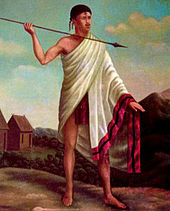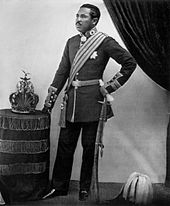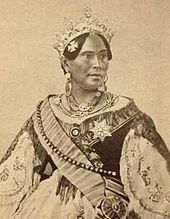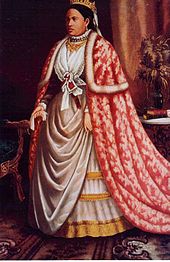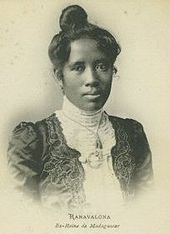- Merina Kingdom
-
Merina Kingdom
Fanjakan'Imerina1540–1897  →
→

Flag Coat of arms Merina Kingdom Capital Antananarivo Language(s) Malagasy Religion Malagasy mythology, Protestantism (From 1869) Government Absolute monarchy Historical era Pre-colonial, Scramble for Africa - Establishment of the monarchy 1540 - Second Madagascar expedition 1897 The Merina Kingdom (ca. 1540–1897) was a pre-colonial south-eastern African state that dominated most of what is now Madagascar. It spread outward from Imerina, the central highlands region primarily inhabited by the Merina ethnic group with a modern and historic political capital at Antananarivo and a spiritual and former political capital at Ambohimanga.
Origin
The Merina people are group within the Malagasy culture of Madagascar for whom the kingdom is named. They lived within the island's central plateau called Imerina ("land seen from afar"). According to oral history, this land was originally inhabited by the Vazimba people, who were vanquished and largely expelled from the land by Merina king Andriamanelo in the 16th century, thereby establishing the Kingdom of Imerina. A united and expanding Imerina was ruled by successors in his line until King Andriamasinavalona quartered the kingdom to be ruled by his four favorite sons, producing persistent fragmentation and warfare between principalities in Imerina. It was from this context in 1787 that Prince Ramboasalama, nephew of King Andrianjaka of Ambohimanga (one of the four kingdoms of Imerina) expelled his uncle and took the throne under the name Andrianampoinimerina. The new king used both diplomacy and force to reunite Imerina with the intent to bring all of Madagascar under his rule – an objective largely completed under his son, Radama I.
The Merina kings and queens who ruled over greater Madagascar in the 19th century were thus the descendants of a long line of hereditary Merina royalty, stretching back in oral traditions to such sources as the first human inhabitants of the island or the son of god himself. A strong caste tradition in many parts of Madagascar saw rulers emerge among diverse ethnic groups, typically from the noble class known as andriana. Most notably, the Sakalava of the Western coastal plains established a thriving kingdom based on maritime trade with European and Arab commercial ships and pirates that dates to at least the 16th century. Political life on the island was characterized by sporadic conflict between the Merina and Sakalava kingdoms, first due to Sakalava slave hunting incursions into Imerina, and later when Merina military forces attempted to bring Sakalava lands under their control.
King Andrianampoinimerina (ca. 1750–1810)
Main article: AndrianampoinimerinaFrom 1800 onward, Andrianampoinimerina expanded his territory beyond Imerina starting the long and difficult task of uniting the other 18 ethnic groups on the island. The king ambitiously proclaimed: Ny ranomasina no valapariako (“the sea is the boundary of my rice-field”). But Andrianampoinimerina stood out from other ambitious kings and tribal chiefs in his administrative ability. The king codified the laws. He supervised the building of dykes and trenches to increase the amount of arable land around Antananarivo. He introduced the metal spade and compelled rice farmers to use it. He operated as an exemplary military commander. By the time of his death in 1810, he had conquered the Bara and Betsileo highland tribes and had started to prepare to push the boundaries of his kingdom to the shores of the island.
King Radama I (1810–1828)
Main article: Radama IAndrianampoinimerina's son Radama I (Radama the Great) assumed the throne during a turning-point in European history that had repercussions for Madagascar. With the defeat of Napoléon in 1815, the balance of power in Europe and in the European colonies shifted in Britain's favor. The British, eager to exert control over the trade routes of the Indian Ocean, had captured the islands of Réunion and Mauritius from the French in 1810. Although they returned Réunion to France, they kept Mauritius as a base for expanding the British Empire. Mauritius’s governor, to woo Madagascar from French control, recognized Radama I as King of Madagascar, a diplomatic maneuver meant to underscore the idea of the sovereignty of the island and thus to preclude claims by any European powers.
Radama I signed treaties with the United Kingdom outlawing the slave-trade and admitting Protestant missionaries into Madagascar. On the face of it, the terms of these treaties seem innocuous enough, but Protestant missionaries would spread British influence as well as Christian charity; and outlawing the slave-trade would weaken Réunion by depriving that island of slave-laborers for its sugar-plantations. In return for outlawing the slave trade, Madagascar received what the treaty called "The Equivalent": an annual sum of a thousand dollars in gold, another thousand in silver, stated amounts of gun powder, flints, and muskets, plus 400 surplus British Army uniforms. The governor of Mauritius also sent military advisers who accompanied and sometimes led Merina soldiers in their battles against the Sakalava and Betsimisaraka. In 1824, having defeated the Betsimisaraka, Radama I declared, “Today, the whole island is mine! Madagascar has but one master.” The king died in 1828 while leading his army on a punitive expedition against the Betsimisaraka.
Main article: Ranavalona IThe 33-year reign of Queen Ranavalona I, the widow of Radama I, was characterized by a struggle to preserve the cultural and political sovereignty of Madagascar from French and English colonial designs. The queen repudiated the treaties that Radama I had signed with Britain and in 1835 after issuing a royal edict prohibiting the practice of Christianity in Madagascar, she expelled British missionaries from the island and began persecuting Christian converts who would not renounce their religion. Ranavalona died in 1861.
King Radama II (1861–1863)
Main article: Radama IIRanavalona's son and heir, King Radama II, grew up under the influence of French nationals in Antananarivo. On June 28, 1855, while still Crown Prince, he signed the Lambert Charter giving Joseph-François Lambert, an enterprising French businessman, the exclusive right to develop all minerals, forests, and unoccupied land in Madagascar in exchange for a 10-percent royalty payable to the Merina monarchy. In years to come, the French would cite the Lambert Charter as justification for the Franco-Hova War and the annexation of Madagascar as a colony.
In his brief two years on the throne, King Radama II re-opened trade with Mauritius and Réunion, invited Christian missionaries[1] and foreigners to return to Madagascar, and re-instated most of Radama I’s reforms. His liberal policies angered the aristocracy, however, and Rainivoninahitriniony, the prime minister, engineered a coup d’état which resulted in the King's apparent death by strangling, although some have argued that he may have survived the attempted murder and lived to old age in anonymity.
Queen Rasoherina (1863–1868)
Main article: RasoherinaA council of nobles (andriana) headed by Rainilaiarivony approached Rabodo, the widow of Radama II, the day after the death of her husband. They gave her the conditions under which she could succeed to the throne. These conditions included the suppression of trial by ordeal as well as the monarchy's defense of freedom of religion. Rabodo, crowned queen on May 13, 1863 under the throne name of Rasoherina, reigned until her death on April 1, 1868.[2]
The Malagasy people remember Queen Rasoherina for sending ambassadors to London and Paris and for prohibiting Sunday markets. On June 30, 1865, she signed a treaty with the United Kingdom giving British citizens the right to rent land and property on the island and to have a resident ambassador. With the United States of America she signed a trade agreement that also limited the importation of weapons and the export of cattle. Finally, with France the queen signed a peace between her descendants and the descendants of the Emperor of France.[3] Rasoherina married her Prime Minister, Rainivoninahitriniony, but public outcry against his involvement in the murder of Radama II soon forced his resignation and exile to Betsileo country south of Imerina. She then married his brother, Rainilaiarivony, head of the army at the time of Radama II's murder who was promoted to the post of Prime Minister upon the resignation and exile of his older brother. Rainilaiarivony would rule Madagascar from behind the scenes for the remaining 32 years of the Merina monarchy, marrying each of the final three queens of Madagascar in succession.
Main article: Ranavalona IIIn 1869 Queen Ranavalona II, previously educated by the London Missionary Society, underwent baptism into the Church of England and subsequently made the Anglican faith the official state religion of Madagascar.[4]
She subsequently had all the sampy (ancestral royal talismans) burned in a public display. Catholic and Protestant missionaries arrived in numbers to build churches and schools. The reign of Queen Ranavalona II was the heyday of British influence in Madagascar.
Main article: Ranavalona IIIHer public coronation as queen took place on November 22, 1883 and she took the name Ranavalona III. As her first order of business she confirmed the nomination of Rainilaiarivony and his entourage in their positions. She also promised to do away with the French threat.[5]
The end of the monarchy
Angry at the cancellation of the Lambert Charter and seeking to restore property confiscated from French citizens, France invaded Madagascar in 1883 in what became known as the first Franco-Hova War (Hova as a name referring to the Merina aristocrats). At the war’s end, Madagascar ceded Antsiranana (Diégo Suarez) on the northern coast to France and paid 560,000 gold francs to the heirs of Joseph-François Lambert. In Europe, meanwhile, diplomats partitioning the African continent worked out an agreement whereby Britain, in order to obtain the Sultanate of Zanzibar, ceded its rights over Heligoland to the German Empire and renounced all claims to Madagascar in favor of France. The agreement spelled doom for the independence of Madagascar. Prime Minister Rainilaiarivory had succeeded in playing Great Britain and France against one another, but now France could meddle without fear of reprisals from Britain.
In 1895, a French flying-column landed in Mahajanga (Majunga) and marched by way of the Betsiboka River to the capital, Antananarivo, taking the city’s defenders by surprise since they had expected an attack from the much closer eastern coast. Twenty French soldiers died in combat and 6,000 died of malaria and other diseases before the second Franco-Hova War ended. In 1896, the Merina Kingdom was put under French protection as the Malagasy Protectorate and in 1897 the French Parliament voted to annex the island as a colony, bringing the 103-year-old Merina monarchy to a close.[6]
See also
- List of Malagasy monarchs
- List of colonial heads of Madagascar
- List of Presidents of Madagascar
- Prime Minister of Madagascar
References
- ^
 "Madagascar". Catholic Encyclopedia. New York: Robert Appleton Company. 1913.
"Madagascar". Catholic Encyclopedia. New York: Robert Appleton Company. 1913. - ^ Frédéric Randriamamonjy, Tantaran'i Madagasikara Isam-Paritra (The history of Madagascar by Region), pages 529–534.
- ^ Frédéric Randriamamonjy, Tantaran'i Madagasikara Isam-Paritra (The history of Madagascar by Region), pages 529–534.
- ^ Madagascar now has three dioceses in the autonomous Church of the Province of the Indian Ocean, part of the Anglican Communion. [1] retrieved on September 14, 2006.
- ^ After the French took control of the island and abolished the monarchy, she was sent to live in exile first in Reunion island and shortly thereafter in Algeria, where she died in 1917. Her body was returned to Madagascar and buried in a tomb in the Rova palace complex in Antananarivo. Frédéric Randriamamonjy, Tantaran'i Madagasikara Isam-Paritra (History of Madagascar by Region), pg 546.
- ^ Virginia Thompson, Richard Adloff. The Malagasy Republic: Madagascar todayI. Stanford University Press. pp. 504..
Bibliography
- Rebecca L. Green: Merina. The Rosen Publishing Group, New York, 1997, ISBN 0-823-91991-9 (The heritage library of African peoples). Google Books
- Matthew E. Hules, et al (2005). The Dual Origin of the Malagasy in Island Southeast Asia and East Africa: Evidence from Maternal and Paternal Lineages. American Journal of Human Genetics, 76:894–901, 2005.
- Mervyn Brown (2000). A History of Madagascar. Princeton: Markus Wiener Publishers. ISBN 1-55876-292-2.
- Stephen Ellis and Solofo Randrianja, Madagascar – A short history, London, 2009
- Brown, M. (1978) Madagascar Rediscovered: A History from Early Times to Independence (London: Damien Tunnacliff)
- Campbell, G. (1981) Madagascar and slave trade, 1850–1895, JAH
- Thompson, V. (1965) The Malagasy Republic: Madagascar today. Stanford University Press
External links
Categories:- Former monarchies of Africa
- Former countries in Africa
- States and territories established in 1540
- States and territories disestablished in 1897
- History of Madagascar
- 1896 disestablishments
- States and territories established in 1787
Wikimedia Foundation. 2010.


